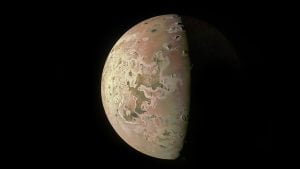

During Juno’s flyby on October 15, 2023, it took some photos of Jupiter’s fifth moon, Io. The latest images of the volcanic beauty are truly remarkable, offering a mesmerizing view of the most volcanically active body in our solar system.
Io’s unique surface looks like it’s been scarred or tie-dyed, with swirls of light and dark spots. Large patches of molten-red patches are particularly striking, vividly standing out against the rest of Io’s surface. Io houses lakes of molten silicate lava on its surface. The newly released images from Junowere processed by dedicated citizen scientists using raw data, showing these dark, molten-red patches in intricate detail.
NASA shared the photos on X (formerly known as Twitter). But that’s not all. The JunoCam instrument aboard Juno has also provided data that NASA used to create a time-lapse video of Io. This video showcases the volcanic moon from different angles, offering a closer look at the spacecraft’s journey.
For a bit of cosmic perspective, the solar system’s giant, Jupiter, has 92 moons following it. Io stands out not just because of its volcanic activity, but also its size. It’s slightly larger than our own moon and ranks as the fourth-largest moon in the solar system. It’s also Jupiter’s third-largest moon and the innermost of the Galilean satellites. This title references the four Jupiter moons Galileo Galilei discovered in 1610, marking them as the first celestial objects observed to orbit an entity other than the sun.
NASA/JPL-Caltech/SwRI/MSSS/Kevin M. Gill
As I mentioned, Io is the most volcanically active body in our solar system. Hundreds of volcanoes on its surface erupt frequently, spewing molten lava and sulfurous gas plumes hundreds of miles up into its atmosphere. And guess what? You can even observe this spectacular show from Earth. You’ll need a powerful telescope, though.
NASA has made Juno’s images available for everyone to download, process, and even contribute to the study of this data. So, if you want to contribute, you can be one of NASA’s citizen scientists, too.
NASA/JPL-Caltech/SwRI/MSSS/Ted Stryk
NASA/SwRI/MSSS/Navaneeth Krishnan S
[via Space.com]







